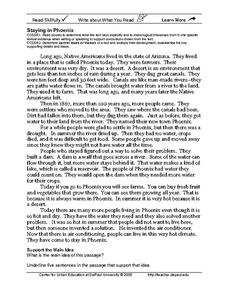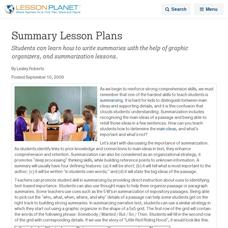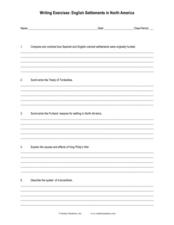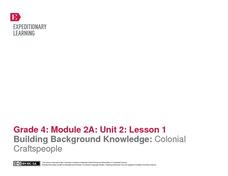Summarizing Teacher Resources
Find Summarizing lesson plans and worksheets
Showing 16,903 resources
Curated OER
Staying in Phoenix
Read to learn! Here is a one-page informational passage about inhabitants of Phoenix, Arizona. Learners will read to make logical inferences and determine the central idea or theme. Prompts ask the class to identify the main idea and...
K12 Reader
Biography of Abraham Lincoln
One skill essential to reading comprehension, is learning how to summarize a text. After reading a biography of Abraham Lincoln, readers demonstrate this ability by crafting a brief summary of Lincoln's life.
Curated OER
Language Arts: Plot Summary
Eighth graders implement plot summary organizers to identify essential elements such as conflict and resolution in literature. In pairs, they retell fairy tales to each other and complete plot summaries about them. As students read new...
Curated OER
Summary of operations with integers
In this integers worksheet, students perform a summary of how to properly perform operation on integers. Addition, subtraction, multiplication, and division operations are shown with signed integers. Dividing by zero is also...
Curated OER
Summary Lesson Plans
Students can learn how to write summaries with the help of graphic organizers, and summarization lessons.
Curated OER
Teaching Summarization
Learning to differentiate major and minor textual events can help students learn how to summarize.
Curated OER
Chunks, Chunks, And More Chunks!
Pupils summarize a selected piece of text nonfiction text. After reviewing the process for summarizing, students read a nonfiction article, highlighting important information as they read. They write a summary paragraph using the five...
Curated OER
Let's Get it Together! Reading to Learn
Let’s learn about frogs! Young readers are led through “Freaky Frogs,” a non-fiction article. Teach learners how to edit an article so there are fewer details to sift through. After talking through the article, they learn the six steps...
Curated OER
Talking Sticks Literature Circle
Following the six-step process for a talking sticks literature circle, group members choose a leader for the discussion, summarize the reading, discuss journal entries and questions, set reading goals, and write reflections. I think this...
Curated OER
Only the Facts
Practice the strategy of summarizing to gain meaning and knowledge from an informational text. Young readers highlight supporting details and main ideas, and then they use this to summarize two articles: "The Great Quake" and "What...
Curated OER
Reading Worksheet
In this reading worksheet, students read a given portion of a book, summarize the information, select vocabulary words, write questions and answers about the reading, and draw an illustration of their favorite part. Students complete...
Curated OER
The Bill of Rights is for US Today
The first ten Amendments of the U.S. Constitution are vital for young people to understand. Provide the foundation of the laws that govern our country with this junior high school activity. Groups use the newspaper to identify rights...
Curated OER
Researching the Past
Learners research the western movement in order to learn note taking strategies with nonfiction texts. They use the Internet to search for important information about the western movement using the Cornell Notes note-taking system. They...
Curated OER
Those Fabulous Fables
A video leads off this activity on fables, introducing the class to this important form of traditional storytelling. The group defines fable and hears an explanation of the origin of this type of folk tale. They summarize the story they...
Curated OER
Writing Exercises: English Settlements in North America
A great writing exercise should have it all. This one requires learners to think critically about cause and effect, compare and contrast, and summarizing. They compose responses to five short answer questions regarding Spanish and...
Curated OER
Como Resumir
Improve the reading ability of your intermediate and advanced Spanish speakers. As they read, they record 10 words they deem important to the text. Then, they summarize the main points, and finally they write an entire paragraph...
Teacher's Corner
Dr. Seuss Book Report - Setting
A great way to incorporate a beloved author into the classroom, especially during the month of March. This book report activity requires young authors to write a short summary of their favorite Dr. Seuss book. It's up to you to...
Teacher's Corner
Dr. Seuss Book Report - Solution
A great way to incorporate a beloved author into the classroom. This book report learning exercise requires young readers to write a short summary of their favorite Dr. Seuss book. It's up to you to decide how long the summary should be....
Teacher's Corner
Dr. Seuss Book Report - Problem
A simple book report activity requires young readers to write a short summary of their favorite Dr. Seuss book. It's up to you to decide how long the summary should be. Lastly, individuals illustrate the problem in the book.
EngageNY
Building Background Knowledge: Colonial Craftspeople
In the first lesson plan of this unit on colonial trade, fourth graders gain background knowledge of different jobs performed by early colonists. The class begins with a slide show presentation that includes a variety of great...
Curated OER
Dragonwings: Evaluate Chapters 10-12
As your class finishes the novel Dragonwings, use these culminating projects. A vocabulary list is given for chapters eleven and twelve and either an epitaph or letter activity concludes the book. The final project consists of creating a...
Curated OER
Engaging Young Scientists with Inquiry: Part Two
Evaluating data and learning to communicate the results is a big piece of the inquiry puzzle.
Teacher's Corner
Dr. Seuss Book Report - Scene
A one-page book report activity requires young readers to write a short summary of their favorite Dr. Seuss book. It's up to you to decide how long the summary should be. Lastly, individuals draw an illustration of their favorite...
Polk Bros Foundation
Show, Then Write What You Learn
After reading a text or covering a new topic, have class members fill out the four boxes on this page with facts. Individuals can use words or drawings to represent the facts.

























